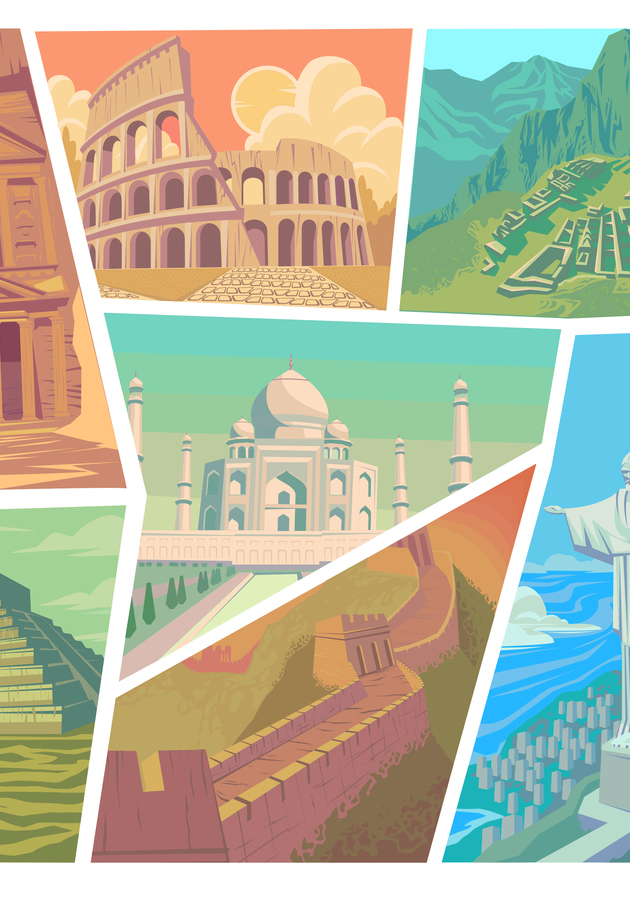The Seven Wonders of the Ancient World were a collection of monuments selected by ancient Greek writers as being astonishing examples of human creativity and construction, as well as embodiments of the quality of “wonder,” due to their capacity to inspire awe and admiration in those who beheld them. The Wonders were, in chronological order of construction, the Great Pyramid of Cheops at Giza, the Hanging Gardens of Babylon, the Statue of Zeus at Olympia, the Temple of Artemis at Ephesus, the Mausoleum at Halicarnassus, the Colossus of Rhodes, and the Lighthouse of Alexandria.
Although the list, in the present form, didn’t stabilize until the Renaissance, the original catalogue can be traced back to the 2nd century BC, if not earlier. Its existence immediately raises several questions. To begin with, why did the ancients need a list of wonders? Who was the person who made the original selection and why did he choose only seven monuments? Finally, what was so wonderful and exceptional about the ones he chose? To answer these questions, allow us to travel back in time to the historical period when the list was first composed: the Hellenistic Age.
The Hellenistic Age
Alexander the Great was just 20 years old when he became the leader of the ancient kingdom of Macedon in 336 B.C. By the time he died 13 years later, he had built one of the largest empires in history, stretching from the Balkan Peninsula all the way to India. Too fragile to survive for long, the empire was broken up by a series of conflicts and civil wars fought between Alexander’s strongest generals, known as the Diadochi, or “the Successors.” In less than 50 years, the Wars of the Diadochi fragmented Alexander’s empire into three great monarchies: Egypt under the Ptolemies, Asia under the Seleucids , and Macedonia under the Antigonids. All of them persisted for about two centuries until being crushed by the Romans in 31 BC. The period framed by the death of Alexander and the Roman conquest of the last of the territories he once ruled is referred to by historians as the Hellenistic Age.
The Hellenistic Age was characterized by a widespread interest, if not reverence, for classical Greek culture. The newly established Greek cities and kingdoms in Asia and Africa served as gateways for the export of Greek culture and language to these new realms. Unsurprisingly, the Greeks themselves became heavily influenced by the indigenous cultures of the lands they conquered, and so they began adopting foreign practices and traditions. These exchanges played a fundamental role in the establishment of cosmopolitanism, and prompted a desire to understand, appreciate, and represent the diversity of individual peoples, perhaps for the first time in written history. In addition, they gave rise to a common Attic-based Greek dialect, known as Koine Greek, which became the lingua franca throughout the Hellenistic world. The word “Hellenistic” itself is derived from the Ancient Greek word “hellazein,” which means “to speak Greek, or identify with the Greeks.”
Indeed, to quote archaeologist Paul Jordan, “The Hellenistic Age spoke Greek and read Greek and was heir to the religious, artistic and intellectual traditions of the classical Greeks; but it encompassed, too, the rougher ways of the Macedonian Greeks from whom Alexander the Great himself had sprung, as well as the oriental habits of the peoples brought into the fold in the east.” Thus, in Hellenism, we see not only the first international culture but also “the first light of our own modern world, with its large-scale political organization, its vigorous commerce with money in coinage, and an international language written in an easily learned alphabet; also with its town planning, its confidence in technology and its cosmopolitan culture; with its multiethnic urbanization, its religious relativism and its professionalism; finally, with its institutionalizing of scholarship.” In short, people, goods and gods moved fluidly around the Hellenistic kingdoms. And so did knowledge.
The original catalogue
“One of the bonuses of Hellenism,” explains Jordan, “was the growth of a sort of university ethos that saw, in the institutions of museums and libraries, the coming-together of scholars to survey and catalogue the achievements of their forerunners in the Greek world, and among the non-Greek communities now under Greek influence.” Whence the idea of catalogues? We don’t know. But we do know that, for some reason, ever since Homer and his epics, the ancient Greeks enjoyed cataloguing things into long inventories and making and updating “best of” lists. They enjoyed composing them, performing them, hearing them, reading them, writing them down, and cutting them into marble. Lists weren’t just considered one of the pinnacles of erudition in Ancient Greece, but also the best means of expressing cultural value in text. Ultimately, lists came not only to record value, but to create it as well.
Almost all of the lists and catalogues composed during the third and second century BC can be trailed to Alexandria, the great modern city that Alexander founded on the Delta coast of Egypt in 331 BC. In a short time, Alexandria became the intellectual capital of the world, in part because of its Great Library. It was there that the scholar-poet Callimachus, working as the main librarian, compiled the legendary “Pinakes,” a comprehensive catalogue of all Greek literature available at the time. Even though lost today, the “Pinakes” remained a model for cataloguing knowledge throughout the Mediterranean for millennia. In addition to this master-catalogue, Callimachus also produced a few others, more specialized and concerned with individual topics. One of them was a book titled “Curiosities from All over the World.” Written around 270 BC, this was the work that established the idea of cataloguing wonderful things.
Even though Callimachus’ book hasn’t survived, it’s unlikely that it restricted itself to the seven most wonderful of wonders. To find the first record of such a list we have to go a little further in time and comb through a collection of Ancient Greek poetic fragments called the “Palatine Anthology.” In it, there is an awe-inspiring epigram by an obscure poet called Antipater of Sidon which glorifies the beauty of the Temple of Artemis by comparing it to six other brilliant monuments. It goes like this: “I’ve looked on the walls of invincible Babylon, which chariots may race along, and on Zeus beside the river Alpheus! I’ve seen the Hanging Gardens and the Colossus Sun-God, the great man-made mountains of the tall Pyramids, and the gigantic tomb of Mausolus. But when I saw the sacred home of Artemis that reaches up to the clouds, the others were put in the shade, for the Sun has never seen its equal outside of Heaven.”
The stabilization of the list
Antipater’s beautiful little epigram was probably composed sometime around 130 BC. Modern researchers say that it reveals at least a few things of historical importance. First of all, that by the end of the second century BC, some catalogue of wonders was already firmly established in the imagination of the Hellenistic Age. After all, it is evident that the selection of monuments in the poem isn’t haphazard, but rooted in a preexisting (and probably widely known) compilation. The selection itself reveals that the original list of wonders was not quite the same as the one we are familiar with today. Although six of the monuments Antipater mentions eventually made their way to the canonical list of wonders, he does omit the Lighthouse of Alexandria, substituting it for the Walls of Babylon. Even so, the number of wonders he lists is, again, seven. But why seven?
Essentially, for the same reason as there are seven days of the week. Namely, in the wake of Alexander’s death, as Ancient Greeks imported the seven-day week from the conquered Babylon, they reignited their enthusiasm for the magical properties of the number “seven.” They already had Seven Wise Men and Seven Attackers against Thebes, so they decided to add another canon of seven, this one recording the most beautiful monuments scattered around Alexander’s vast empire. Before Alexander’s conquests, the Ancient Greeks saw themselves as the summit of world culture and civilization. However, it was only after them that they were really able to compare their achievements with those of other great cultures. This didn’t change their mind, though: five of the seven wonders they listed were carved, cast or constructed by Greek or Hellenistic artists and architects. The only exceptions were the Pyramids of Giza and the Hanging Gardens of Babylon, the latter of which may have never even existed.
Either way, Antipater’s list went on to change several times throughout the following centuries, as various writers sought to include new monuments which fit their own particular agendas. For example, in the late first century AD, the Roman epigrammatist Martial added the newly completed Colosseum to the list of wonders. Several centuries later, Christian bishop Gregory of Tours substituted pagan entries (such as the Zeus and Artemis monuments) with fabled Old Testament edifices, such as the Ark of Noah and the Temple of Solomon. He was also one of the earliest writers to include the Lighthouse of Alexandria on the list. After a few more rearrangements during the Medieval Age, our modern canon of the Seven Wonders of the Ancient World was finally established during the Renaissance. Hence, it bears remembering that the list we now refer to as the Seven Wonders of the Ancient World was as much a product of the minds of ancient thinkers as it was of Renaissance conventions.
The quality of wonder
Not long after Antipater wrote his now-famous epigram, Alexandrian engineer Philo of Byzantium (or at least someone who used his name to gain historical credibility), wrote a brief travel guidebook titled, “The Seven Sights of the World.” Albeit in a slightly damaged 9th-century Italian copy, the work has amazingly survived to this day. From the remaining pages, we can safely conclude that Antipater’s list of wonders must have been the most popular in the Hellenistic Age, since Philo describes the exact same seven monuments. However, he never calls them “wonders,” but (as stated in the title) “sights,” or rather, “things to be seen.” In fact, the majority of ancient Greeks were like Philo and spoke of “sights” whenever they spoke of the Pyramids of Giza or the Walls of Babylon. It was only later, in Roman times, that the “sights” became “wonders,” mostly due to the similarity of the two words in Ancient Greek: “theamata” and “thaumata.”
There was, of course, another reason why the “sights” were destined to become “wonders”: the monuments themselves. Being the product of singular architectural, engineering, and artistic hubris, they were wonderful enough to arouse immediate awe. Each of them represented the epitome of human achievement in different aspect of technical skill. The Pyramids of Egypt were the supreme example of building in stone, the Hanging Gardens of Babylon of skill in harnessing running water, and the Colossus of Rhodes of casting in bronze. Excepting the Pyramids, the lavishly ornate Mausoleum at Halicarnassus was the biggest tomb in the Graeco-Roman world, and the Lighthouse of Alexandria – the tallest man-made structure in the world. Finally, both the gigantic Statue of Zeus at Olympia and the Temple of Artemis at Ephesus combined scale with vivacity of elaborate decoration, not to mention resources with massive engineering effort.
The Seven Wonders were attention-grabbing by design: too enormous to be overlooked, they led the viewer on to imagine the labor needed to create them and the control of resources which lay behind such mighty works. The message they carried was one of power and beauty, of legitimacy and authority. Their objective, additionally, was securing remembrance. Yet, of the Seven Wonders, only the oldest one, the Pyramids of Giza, can be seen by modern travelers. The rest were all destroyed long ago, most of them even before Renaissance writers could visit them. Even so, for the sixty or so years between 280 BC and 225 BC, all Seven Wonders stood tall around the Mediterranean coast, proclaiming the majesty of their conception and the ambition of their creators. Proclaiming, simultaneously, the birth of a new, multicultural world, one that was as much bereft of gods as it was populated with godlike kings and artists.
Sources
Main
- Paul Jordan, Seven Wonders of the Ancient World (Routledge, 2002).
- Christopher Scarre, ed. The Seventy Wonders of the Ancient World (Thames & Hudson, 1999).
Other
- Russell M. Lawson, “Seven Wonders of the Ancient World,” Science in the Ancient World (ABC-Clio, 2004), pp. 223-4.
- Peter D'Epiro & Mary Desmond Pinkowish, What Are the Seven Wonders of the World?: And 100 Other Great Cultural Lists (Anchor, 1998), pp. 179-187.
- Athena Kirk, “Introduction: The Tally of the Text,” Ancient Greek Lists: Catalogue and Inventory Across Genres (Cambridge University Press, 2021), pp. 1-16.
Historical
- Summer Trentin and Debby Sneed, “The Hellenistic Period: Cultural & Historical Overview,” University of Colorado Boulder (June 14, 2018) [https://www.colorado.edu/classics/2018/06/14/hellenistic-period-cultural-historical-overview]
- History.com Editors, “Hellenistic Greece,” A&E Television Networks (February 4, 2010). [https://www.history.com/topics/ancient-history/hellenistic-greece]





























